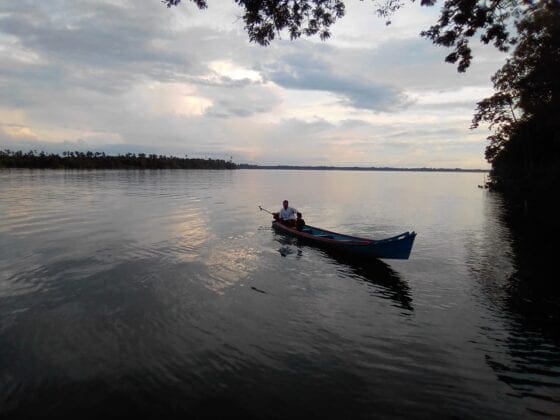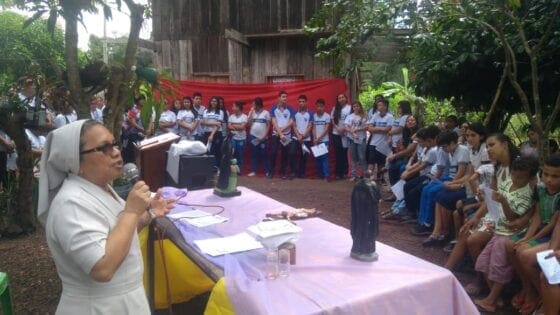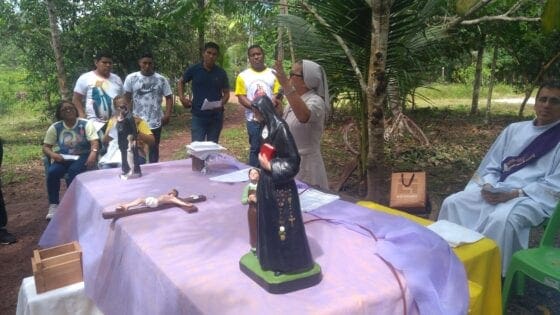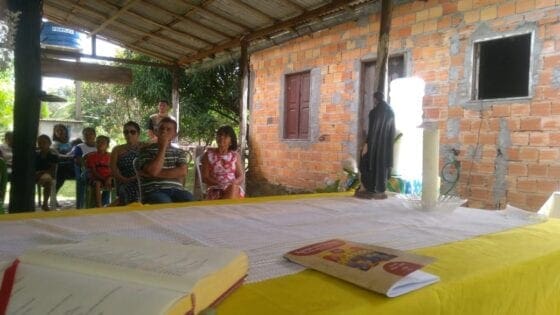 The work of the Congregation of the Mission in the neighborhood of Canaan, in Marituba, metropolitan region of the capital of the state of Pará (Brazil), began with Bishop Antonio de Assis Ribeiro’s pastoral invitation. He is a Salesian and auxiliary bishop of the Archdiocese of Belém.
The work of the Congregation of the Mission in the neighborhood of Canaan, in Marituba, metropolitan region of the capital of the state of Pará (Brazil), began with Bishop Antonio de Assis Ribeiro’s pastoral invitation. He is a Salesian and auxiliary bishop of the Archdiocese of Belém.
Founded on 27 June 2018, the Missionary Area receives the collaboration of priests, deacons, lay people, benefactors, and the faithful from other parishes of the Episcopal Region, including our own. The parish community of Saint Raimundo Nonato, the Saint Vincent de Paul Seminary, and the Daughters of Charity are a reference of support for the Vincentian work carried out in Marituba.
So far eight communities have been founded that demonstrate the ecclesial and pastoral effort of the Archdiocese. These are: Saint Francis of Assisi (the first chapel before the establishment of the Missionary Area), Our Lady of Perpetual Help (current seat), Queen Mother, Our Lady Help of Christians, Saint Jude Thaddeus, Our Lady of Grace, Saint Anthony of Lisbon, and Saint Vincent de Paul. This latter is located six kilometers from the Missionary Area’s pastoral seat.
On 16 December 2018, with the enthronement of Saint Vincent de Paul’s image at Mass celebrated under a tree, the Congregation of the Mission, the other branches of the Vincentian Family, and a group of faithful from the Parish of Saint Raimundo confirmed the beginning of the evangelizing mission of the Saint Vincent de Paul community in Riacho Doce, the agricultural area of the Canaan neighborhood’s immense territory.
 According to the Church’s thought, “pastoral activity needs to go beyond merely the territorial limits of the Parish, to make ecclesial communion more clearly transparent by means of the synergy between ministers and diverse charisms, structuring itself as a “pastoral care for all”, at the service of the Diocese and of its mission” (Congregation for the Clergy, Instruction, “The pastoral conversion of the Parish community in the service of the evangelising mission of the Church,” 20 July 2020, no. 123.
According to the Church’s thought, “pastoral activity needs to go beyond merely the territorial limits of the Parish, to make ecclesial communion more clearly transparent by means of the synergy between ministers and diverse charisms, structuring itself as a “pastoral care for all”, at the service of the Diocese and of its mission” (Congregation for the Clergy, Instruction, “The pastoral conversion of the Parish community in the service of the evangelising mission of the Church,” 20 July 2020, no. 123.
“A Church which goes forth” is not only a pastoral call, but also a missionary program that, from the first hour, appears as the most significant mark of Pope Francis’s pontificate. Reaching the peripheries, going to meet the flock that has been lost, proclaiming mercy to sinners and hope to the poor, all this is part of the teaching of the Gospel. Pope Francis says, “A renewal of preaching can offer believers, as well as the lukewarm and the non-practising, new joy in the faith and fruitfulness in the work of evangelization” (EG 11).
In the ecclesial appeal of the Salesian bishop, there are various possibilities for a theological rereading of the meaning of the Congregation’s mission that has arisen especially to evangelize the people of the countryside. The poor people of the countryside have been pushed to the peripheries that represent the real geography of the urban space’s precarity, social abandonment, and human helplessness.
Deprived of the means to survive, the poor on the periphery are transformed into an anonymous mass. The Church does not always succeed in seeing these poor people, precisely because she does not “go forth.” They suffer the pain of “ecclesial invisibility.” That kind of suffering is also existential in nature. However, there is a vital impulse in the periphery that must be welcomed from the poor, as the Pope reminds us, “The new evangelization is an invitation to acknowledge the saving power at work in their lives and to put them at the centre of the Church’s pilgrim way” (EG 198).
The mission that makes us “journey” to the furthest periphery of Marituba recovers the sense of the charism’s origin in 1617 France. From this historical framework, the charism spread by Vincent de Paul assumed different modes of service to the poor in face of the needs that arose in his milieu. After the birth of the Confraternities of Charity, the missions in Folleville encouraged the establishment of the Congregation of the Mission in 1625 and the social plague in the Paris streets gave rise to the Company of the Daughters of Charity in 1633. To serve the poor, the daughters of Vincent and Louise made the streets of the French capital a real “field hospital.”
Folleville is any place in the world identified as “mission territory.” For us, Priests of the Mission, the district of Canaan is the “theological Folleville” of the so-called missionaries of the Church of Belém. For the Vincentian Family, it is the social place for reinventing the charism.
 Charity uses theological and geographical places as a hermeneutic key to give continually new meaning to the Vincentian identity alongside the poor and despised of our time. Mission is the language of charity going forth, “What happiness, Messieurs, what happiness! To do what Our Lord came from heaven to earth to do, and by means of which we’ll go from earth to heaven to continue the work of God, who avoided the towns and went to the country to seek out those who were poor,” Vincent said to his missionaries (CCD XII, 4).
Charity uses theological and geographical places as a hermeneutic key to give continually new meaning to the Vincentian identity alongside the poor and despised of our time. Mission is the language of charity going forth, “What happiness, Messieurs, what happiness! To do what Our Lord came from heaven to earth to do, and by means of which we’ll go from earth to heaven to continue the work of God, who avoided the towns and went to the country to seek out those who were poor,” Vincent said to his missionaries (CCD XII, 4).
The Congregation’s presence together with “the poor people of the countryside” of Riacho Doce shows the charism’s missionary strength that reaches to the furthest periphery, opening new paths through the bush for the proclamation of the Gospel.
Father Adriano Sousa Santos, CM
padiretoamaz@hotmail.com
Belém-Pará, 11 September 2020

